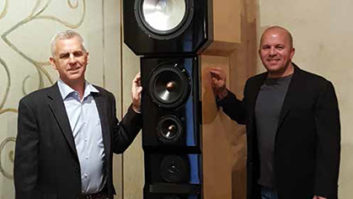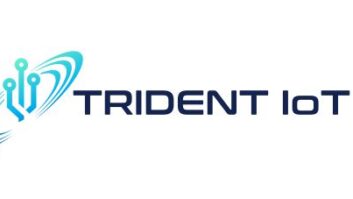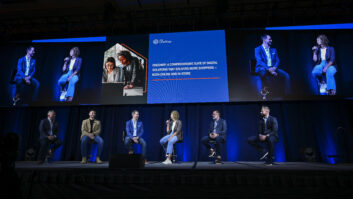One of the great privileges of attending the National Association of Broadcasters annual convention as a reporter is the special invitation to attend the breakfast held there by CBS for the chief engineers of its owned and affiliate television stations. In addition to hearing first-hand reports from network engineering executives and outside expert guests on the status of the latest in broadcast technology there is an added benefit. Each year the attendees receive a small gift with the CBS logo. This years gift was more than a jacket or T-shirtit actually summed up a major theme of the convention that we all need to be aware of in the months ahead.
As they left, each attendee was given a countdown clock, set to tick off the days, hours, minutes, and seconds until 11:59:59 p.m., Tuesday, February 17, 2009. Barring an unforeseen event, when the clock strikes midnight and the calendar page turns that night, the nearly 70-year history of analog terrestrial television broadcasting in the United States will end.
Receiving that countdown clock, and now having it sit on a shelf above the computer screen brings an air of certainty and finality to the transition process. Its funny how something as seemingly benign as an inexpensive clock brings the future into focus.
Lest you think we focus only on freebies at events we cover, heres a simple and direct statement from one of the speakers at the CBS Breakfast: The date [2/17/09] is not going to change. Anyone with their head in the sand who thinks they can hold off on changing out analog sets, installing converter boxes where appropriate, or determining what to do about sets in your clients homes fed by cable has got it wrong. One more time: The date is not going to change.

An Important Point
Curiously, some things surrounding the end game of the digital transition will not change when analog broadcasts stop. This involves things you need to know that were announced both at the NAB show and in the preceding months. For example, in late November last year and in late March this year, two weeks before NAB, the FCC issued separate Report and Order documents that serve as Further Notice of Proposed Rulemaking. The reports lay down the law as to how cable systems and satellite carriers, respectively, must carry digital broadcast signals starting on February 18, 2009. Given the likelihood that most of your clients receive their main home television signals through one of these means, this is important.
Hopefully you have already taken a television inventory for each of your clients homes, noting which sets are already digital, which are still analog, how signals are fed to each set, and where they are located. This is important, because it is probable that even the most technically minded and well-heeled client may not wish to immediately swap out every set and replace it with a new one. Particularly given situations such as under-counter sets, or sets inset into mirrors or placed in special millwork, this might not even be practical or possible. Face it: you are going to have to deal with getting analog signals to some sets for a while.
Cable and Satellite Options
When it comes to satellite, the new rules published just before NAB make it reasonably easy. If a provider carries the signal of one local broadcaster in HD into a given market, an aptly named HD Carry One, Carry All rule says that they have to carry the signals of all broadcasters in the market in HD. Because all current satellite STBs, and most that well see for the next few years, will have an analog output, you may have to swap the box over time, but at least you can wait to replace the set for a while.
For cable, it is a bit different. Here, the system operators are given two choices in how they continue to provide analog carriage of local broadcasters signals. The first option is to continue to provide analog signals directly, as most systems do now. For instances where the cable is connected directly to a TV without a converter box, or where a VCR, DVD recorder or earlier generation DVR (e.g., Series 1 or Series 2 TiVo) is in use, this is the easiest way to go. Where the possibility of problems for you may arise is in the other option. Systems may alternatively elect to go all-digital and carry every local station and other program channel digitally.
Yes, the FCC states that they must provide a converter box that makes signals available to analog sets for another three years, at least until February 2012. This keeps the sets that are already in place viable. However, as cable systems increasingly go all-digital, and some go further by adding switched digital video, (which also requires a set-top box) you have the added burden of having to find a place to put a box where there is not one today. This is not insurmountable, but its clearly something to plan for. Do you know what the plan is for each cable system you have to deal with on behalf of your clients? As that countdown clock ticks down the days, it is a good idea to find out.
The FCC rules also state that cable systems and satellite providers may not materially degrade the quality of delivered signals through any digital/HD to analog/SD down conversion, and they must bear that cost. One piece of good news coming out of NAB is that the major networks announced that they will do the down conversion themselves for delivery to cable systems. Their vested interest assures that the quality will be top notch.
AFD and Mobile Video
There was a great deal of discussion at NAB about AFD, or Active Format Description. This technology embeds a code in the digital data stream that tells a receiver or set top how to optimally display the incoming video when it is down-converted or at any time when the aspect ratio of the program and the display do not match. Implementation of AFD is far from universal at this time, but as we all face the prospect of integrating analog and digital sets of all aspect ratios with a mix of cable, satellite and off-air signals, it is a welcome prospect.
NAB also focused a fair amount of attention on use of digital broadcasting technology to send signals to moving vehicles and portable devices as part of the ATSC transport stream. Early takes at this sort of technology have been shown at NAB in past years, but this time around everyone was serious. An alphabet soup of organizations is involved in testing by the Association of Maximum Service Television (MSTV), on behalf of the Open Mobile Video Coalition (OMVC) to create a finding in an Independent Demonstration of Viability (IDOV) that will be submitted to the Advanced Television Systems Committee (ATSC) for a decision that will likely be endorsed by the Federal Communications Commission (FCC).
Confused? At NAB the confusion was not over the letters in the bowl of standards soup, but rather as to which of three rival systems will be approved. The Mobile Pedestrian Handheld (MPH) system was proffered by LG, with support from leading transmitter supplier Harris Corp., while the Advanced Vestigial Sideband (A-VSB) system was developed by Samsung with support from MobiTV, Nokia, Rohde & Schwarz and SES-American, and an unnamed system put up by Thomson and chip maker Micronas. MPH and A-VSB both held demos at the show, along with prototypes of receivers and displays in a wide range of form factors.
Saving us all the specter of yet another format battle, the decision as to which system will be chosen was made easier in mid-May as LG and Samsung agreed to cooperate toward what will likely be the standard for in-band, DTV-based mobile broadcasting in the United States and North America. As broadcasters align around the eventual standard, they will still compete with services offered by the cellular carriers, as well as with potential use for mobile video via data transmission by new devices in the spectrum space that broadcasters will vacate after February 17, 2009. Making good on the promise to monetize the digital transition, the so-called 700 MHz Auction raised more than 17 billion dollars when the government auctioned it off back in March.
Beyond the vacated space, there is also the vacant, or white space on unused channels in the remaining broadcast spectrum for between 54 MHz and 698 MHz. Preliminary testing has begun on a variety of devices from a number of manufacturers, and not all of it has been successful to date. Because white space devices have the potential to interfere with the newly assigned digital broadcast channels, they were a hot topic of discussion at NAB.
If this all sounds too mobile for the residential designer/installer, dont ignore the developments in either of these areas. First, as your clients electronic concierge and all around technology wrangler, it shouldnt matter if they are fixed or portable, line-powered, battery-powered, or solar-powered. If they have to do with content that is viewed, listened to, or have data capability, you need to plan how they fit into your clients overall system integration. If you dont do it, rest assured that someone else will. As the picture for new white space and 700 MHz spectrum-based devices becomes clearer, Ill keep you posted.
Content is King
At the end of the day, it isnt just about the gadgets or gear. Content is king, and without something to play, watch or listen to, the best products in the world are just dumb boxes. Even at as technology-driven a convention as NAB, this was very clear.
A good indication of the importance of content was the slogan plastered on the side of the Las Vegas Convention Center during the show. In the past, NAB simply sought to move from the perception that its exhibits, sessions, seminars, events, and meetings were just for broadcasters, welcoming members of the non-broadcast and post-production communities with references to multimedia. Having made that leap, the message on the banners this year was one that we can all embrace: Content makes a cool gadget hot, with a sub-message explaining that the Show was The event for professionals passionate about content.
There has been increased attention this year, not only at NAB, but also at events such as the Hollywood Post Alliances annual Technology Retreat to 3D. Lets just say that it has come a long way from the stock photo of a 1950s audience with red/blue cellophane lens, paper frame glasses that were no doubt used to watch a costume musical or cheesy horror film. In recent years, 3D production has undergone a renaissance, with tests including a wide range of theatrical, special interest and sports programming. Numerous technology companies from start-ups to major players such as Dolby Labs are working on production and distribution/display technology for 3D, and the move to digital cinema will certainly help accelerate the pace of 3D TV.
For now, most 3D content is being shot for theatrical and special-venue exhibition, but the ease of adapting DLP projectors, and to lesser degree, flatpanel displays to 3D is creating a vast universe of potential in-home customers for 3D. Indeed, as rear-projection is fading in popularity due to the price compression for PDP and LCD, the suitability of DLP-based RPTV for 3D is becoming one of the technologys selling points. One need look no further than the DLP displays at CES to see this being promoted as a strong point, along with the 3D demos conducted by Mitsubishi with its laser-driven DLP projector both at CES and more recently at its line show.
Although 3D content libraries are building, there isnt enough yet for the constant stream of programming that would make it an everyday thing. Further, there are still many different technologies being demonstrated and used for production and reproduction, along with the mix of varying types of passive and active glasses, or perhaps at some point, 3D with no glasses at all. As one can expect, the technologies and formats will duke it out to see which one gains the most traction, or perhaps as discussed here with regards to format battles in the past, this may be one where we end up with multiple standards in both the theatrical and home markets.
As with new spectrum devices to deliver content, it is still a bit too early to suggest any clear path for the designer/installer who wants to make every display in a home 3D Ready. Its just too soon for that. However, this is yet another one where you need to keep the technology on your radar so that you are ready to answer questions from clients today and know when to prepare to install products for it tomorrow. Ill be watching this one too, with my 3D glasses on, of course.







